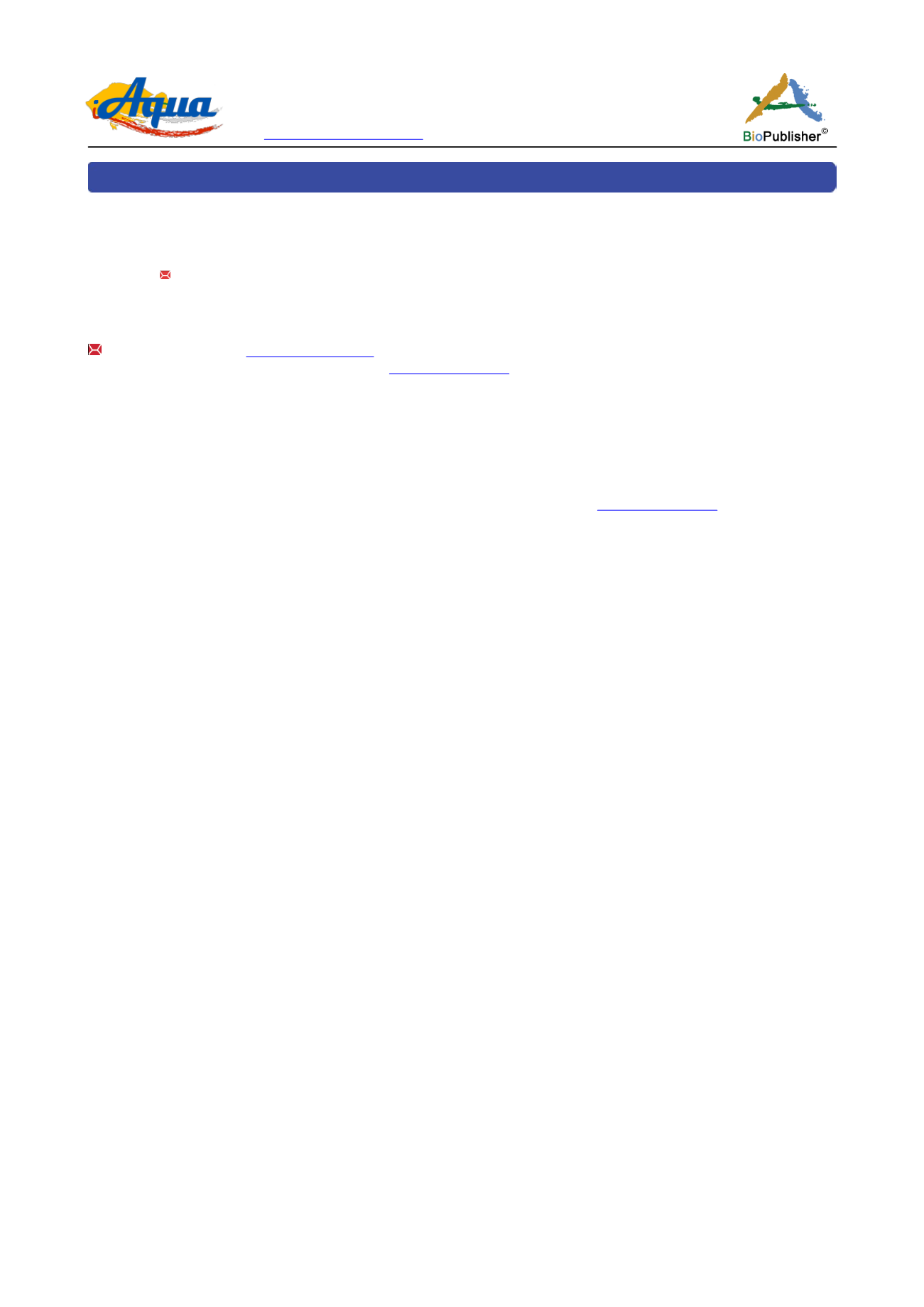
International Journal of Aquaculture, 2017, Vol.7, No.2, 9
-
14
9
Research Report Open Access
Seasonal Variations in Selected Physico-Chemical Parameters of Culture
Systems Used in Raising African Catfish,
Clarias gariepinus (
Burchell, 1822) in
Ibadan, Nigeria
Adeosun O.
1
, Olaifa F.E.
2
, and Akande Gbola R.
3
1 Department of Fisheries Technology, Oyo State College of Agriculture, Igbo-ora, Nigeria
2 Department of Wildlife and Fisheries Management, University of Ibadan, Ibadan, Nigeria
3 Nigerian Institute for Oceanography and Marine Research, 3, Wilmot Point Road, Victoria Island, P.M.B. 80108, Victoria Island, Lagos, Nigeria
Corresponding author Email
International Journal of Aquaculture, 2017, Vol.7, No. 2 doi
Received: 25 Apr., 2016
Accepted: 24 Nov., 2016
Published: 20 Jan., 2017
Copyright © 2017
Adeosun et al., This is an open access article published under the terms of the Creative Commons Attribution License, which permits
unrestricted use, distribution, and reproduction in any medium, provided the original work is properly cited.
Preferred citation for this article
:
Adeosun O., Olaifa F.E., and Akande G.R., 2017, Seasonal variations in selected physico-chemical parameters of culture systems used in raising African catfish,
Clarias gariepinus (
Burchell, 1822) in Ibadan, Nigeria, International Journal of Aquaculture, 7(2): 9-14 (doi
Abstract
This paper examined the effect of culture systems and seasonal change on the physico-chemical properties of pond water
used in culturing of
Clarias gariepinus.
Six farms with the two most common fish culture systems (3 concrete tanks (CTs) and 3
earthen ponds (EPs) were selected based on frequency of harvest and yield. Water quality parameters (pH, temperature, dissolved
oxygen and ammonia) were determined using standard methods. The mean values obtained for each of the parameter were pH (7.23
±0.03 - 7.36 ±0.07), temperature (29.1 ±0.04
°
C - 28.2 ±0.06
°
C), dissolved oxygen (7.5 ±0.05 mg/L - 6.1 ±0.01 mg/L) and
ammonia (0.4 ±0.08 mg/L - 0.6 ±0.03 mg/L) for EP and CT systems, respectively. There was no significant difference (p > 0.05) in
pH values between culture systems and between seasons (p > 0.05). The results indicated that there was significant difference (p <
0.05) in the values of nitrate between season but no significant difference (p > 0.05) between culture systems. Water temperature and
pH remained fairly stable in the two culture systems and in dry and wet seasons. Temperature and Ammonia differed significantly
(p > 0.05) with the culture systems. Total dissolved solids and nitrate differed significantly (p > 0.05) with the seasons. The
physic-chemical water quality recorded in this study showed that water quality was within the range recommended for fresh water
fish, hence favourable for the survival of
C. gariepinus
.
Keywords
Nitrates; Seasonal change;
Clarias gariepinus
; Water quality parameters
1 Introduction
Fish are totally dependent on water to breathe, feed, grow, excrete wastes, maintain salt balance and reproduce.
Water is always a limiting factor in commercial fish production and its quality determines not only how well fish
will grow in an aquaculture operation, but whether or not they will survive. Fish influence water quality through
processes such as nitrogen metabolism and respiration (Bhatnagar and Devi, 2013). Water quality includes; all
physical, chemical and biological factors that influence the beneficial use of water. There are many water quality
variables in pond fish culture but only a few of these normally play important roles. Water used for growth of fish
will not give maximum production if the condition is not optimal for the fish. Therefore, it is very important to
maintain the quality of the water for a successful aquaculture operation. Water quality is determined by variables
like temperature, transparency, turbidity, water colour, carbon dioxide, pH, alkalinity, hardness, unionised
ammonia, nitrite, nitrate, primary productivity, dissolved oxygen, plankton population and others (Bhatnagar and
Devi, 2013).
Clarias gariepinus
has a wide tolerance to temperature as well as low dissolved oxygen and high
salinity (David et al., 2010). Some physic-chemical parameters such as pH, temperature, dissolved oxygen, total
dissolved solids, nitrate, nitrite and ammonia were evaluated. FAO (2013) reported that catfish species had long
been regarded as one of the most suitable species for culture in Africa because of their hardy qualities. Therefore,
the objectives of this study are to study the effect of culture systems and seasonal change on the physic-chemical
properties of water used in culturing
Clarias gariepinus
in Ibadan.


